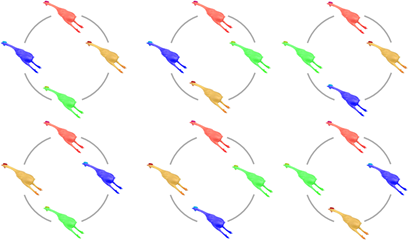Circular Permutations
Tags | |
UUID | af85863a-49b1-11e4-a9fb-bc764e2038f2 |
This equation computes the number of ways that you can arrange n unique objects around a circle.
As you can see illustrated below, a set of four brightly colored dead chickens can be arranged circularly in six different circular permutations.
The number of circular permutations of four unique elements: = (4 - 1) ! = = 6. This means the probability of getting one specific circular permutation from four unique elements is 1 in 6.
This is the special case of computing the number of r-permutations of a set of n elements, where r = n.
Since the number of linear permutations is computed as: , the number of circular permutations is
This in turn gives us the number of circular permutations as
Circular Permutations of Colored Dead Chickens
Here we illustrate the six circular permutation of a set of four unique items -- in this case four differently colored dead chickens.

-- remembering Miss Starrett's class
APPLICATION
A circular permutations can be seen in the relationship between proteins, where the order of peptide sequences within a set of proteins can be arranged in different permutations. This permutation calculation can then compute the number of possible proteins that can be constructed of the set of n peptide sequences.
Engineering strategies to explore protein sequences have been used to enhance the function of old yellow enzyme (OYE), which can be used as a bio-catalyst for stereo-selective trans-hydrogenation of activated alkenes. See abstract: http://pubs.acs.org/doi/abs/10.1021/ja4074886.
Circular permutations come into play in many kinds of combinatorics problems.
Equations and Data Items
- Comments
- Attachments
- Stats
No comments |
